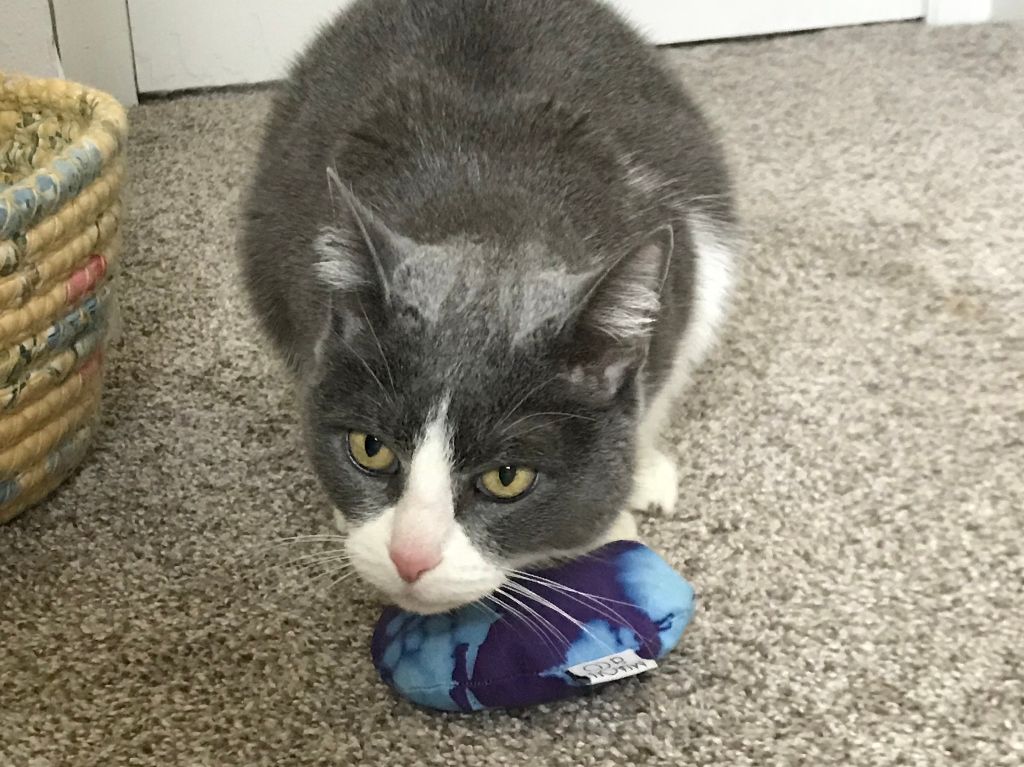Sixteen-year-old Winifred is a grande dame. She is stubborn and opinionated but sweet and affectionate with people, prefers not to interact with the other cats she lives with, and lord help the cat who gets in her favorite spot in the catio. Winifred is also deaf.
Leslie Cobb, cat artist, adopted Winifred in 2018 from a shelter in Berkeley, California, and had no idea Winifred was deaf. Cobb says, “I don’t think the shelter staff or her previous owner were aware. Even my friend who fostered her for a month before I was able to bring her home didn’t realize it. I asked her to try out different names and she said the cat didn’t respond to any of them or to her given name from her previous owner. I only figured it out after she would visibly startle upon catching sight of me in the room and clearly she hadn’t heard me even though she was awake.”
Are You Deaf or Ignoring Me?
Like other cats, deaf cats are rich with personality, preferences, and behavioral quirks. Deafness is an invisible disability that often goes unnoticed until it reaches an advanced stage. In a multicat household it’s more difficult to notice changes because a cat with hearing loss will often rely on hearing companions, seeking visual cues about how to respond. And cats are masters at using all their senses to their fullest; for example, feeling air currents and vibrations with their whiskers.
So how do you know if your cat is deaf or just ignoring you? Some signs:
- Not responding to her name when called or to the crinkly sound of her favorite bag of treats
- No longer reacting to sounds that used to cause distress such as the doorbell, vacuum cleaner, barking dogs, or fireworks
- Sleeping sounder or longer
- Easily startled
- Stops greeting you at the door when you come home, doesn’t realize you’re home, or conversely, becomes needier and clingier when you are home
- Louder meows
Hearing Tests
Cats have a highly developed sense of hearing, one of the broadest among mammals, with a range from 45 to 64,000hz. For comparison, the human range is 64 to 23000hz, and in dogs 67 to 45000hz. This means cats can hear sounds at both ends of the spectrum that we can’t. Hearing at high frequencies is not only a feline superpower that coincides with the frequency of mouse squeaks, it’s also the first to be lost. Essentially, cats lose the hearing range we can’t hear. The loss of high-frequency hearing plays a major role in a cat’s predator skills to hunt and eat.
To test your cat’s hearing at home, choose a variety of objects that cover the spectrum of low-, mid-, and high-frequencies. Use objects or sounds such as the clatter of pots, pans, and lids, a whistle, a squeaky door hinge, a tap on a wood table, a hand clap, and the tread of shoes or boots. When you’re ready to test, choose a time when your cat is rested, calm, and relaxed. Stand behind her so she can’t see you. This also prevent air currents she can detect with her whiskers. Start by making soft sounds and watch for a reaction. If she’s oblivious, increase the noise volume until she reacts. If she doesn’t react to the sounds, there’s a good chance she’s deaf. Call your veterinarian for an evaluation if you think your cat is deaf or has hearing loss.
Causes of Deafness
Deafness is the inability to perceive sound. It may be congenital (present at birth) or acquired. In some cases, hearing loss may be reversible if the underlying cause can be treated, while other causes are permanent. There are two types of hearing loss: 1) Conduction deafness, caused by impairment in air transmission of sound waves to the inner ear and 2) Nerve deafness, the lack of transmission of messages from the nerve to the brain. Nerve deafness can be congenital or acquired.
Like humans, cats can lose their hearing as they age. The loss is gradual over time therefore often unnoticed. As the cat ages, the eardrums thicken and become less flexible and the delicate structures of the inner ear lose their sensitivity to vibration. Deafness in older cats is caused by a combination of nerve damage and the bones of the inner ear fusing together. In short, the older the cat, the more wear and tear the structures experience. Detecting age-related loss requires a BAER (brain stem auditory evoked response) test used in special settings. Your veterinarian can help you find a location. Age-related hearing loss is irreversible.
Cats can also lose their hearing when exposed to loud noises, such as music. If your cat leaves the room when you play your favorite tunes, maybe she’s not throwing shade about your music choice as much as expressing dislike of the volume.
Congenital deafness is a condition that most often occurs in white cats with blue eyes but it is a myth that all white cats or that white cats with blue eyes, green eyes, or one of each is deaf. Congenital deafness is permanent.
Deafness may result as well from inflammation of the inner or outer ear, tumors, polyps, cancer, infectious diseases, trauma, certain medications, or untreated ear mites. Your veterinarian can diagnose ear mites, a tumor, or an infection, advise appropriate treatments, and determine if hearing loss is temporary or permanent.
Living With a Deaf Cat
Deaf cats are happy cats, capable of living a fully enriched life. It’s easy to accommodate their needs; we do it for family and friends who have hearing loss and our pets are family and best friends, right?
Before Winifred, Cobb had two other deaf senior cats, Gladys and Esmeralda. If you have a deaf cat or are thinking about adopting one there are a few things to be aware of, Cobb says.
“Deaf cats aren’t any more difficult than any other cat. You just need to be careful not to startle them and be aware that they can be very loud. They don’t hear their own voices, so they have no idea how loud they are. An advantage of having a deaf cat is they are not afraid of the vacuum cleaner.”
Accommodating cats with congenital deafness is easy because they automatically use their other senses to communicate and gather information from their environment. Cats who’ve suddenly lost hearing or have gradual hearing loss may take a little longer to adjust to the change.
from their environment. Cats who’ve suddenly lost hearing or have gradual hearing loss may take a little longer to adjust to the change.
The safest place for a deaf cat is indoors. She can’t hear outside dangers such as cars, barking dogs, or other noises that could cause injury. She cannot hear you call her name to come home. Inside doesn’t mean devoid of enrichment and activities, though. Give ample toys and playtime.
Provide a window view to see all that’s happening outside. Consider a safe outdoor area such as a catio. If your cat is the adventurous type, consider leashed walks for supervised outdoor excursions.
Visual cues are an important mode of communication with a cat who can’t hear. Cats easily learn to respond to hand signals or a flicking light or laser pointer.
Approach from the front so your cat can see you coming; deaf cats startle easily and feel vulnerable to predators, which amps anxiety. They may appear aggressive and lash out but it’s a self-defense tactic.
“Winifred is a loner. My guess is she’s afraid of being startled since she can’t hear the other cats coming. She’s quick to let them know when they’ve entered her personal space and not afraid to hiss, growl, and attack another cat,” says Cobb.
Use touch and vibration to communicate with your deaf cat. When you enter a room, stomp or walk with solid steps. The vibrations help alert her to your presence.
“I know she can’t hear me but I still talk to her. I face her so she knows I’m listening and responding. I sometimes put my lips on the top of her head to tell her how much I love her so she can feel my breath and the vibration of my voice,” says Cobb.
This article was reviewed/edited by board-certified veterinary behaviorist Dr. Kenneth Martin and/or veterinary technician specialist in behavior Debbie Martin, LVT.
Ramona D. Marek, MS Ed, is an award-winning writer and 2017 recipient of the prestigious Fear Free Pets Award. She writes about pet care, health and behavior, and cats in the arts. She’s also the author of “Cats for the GENIUS.” Her feline muses are Tsarevich Ivan, a joie de vivre silver tabby Siberian, and Natasha Fatale, a full-time diva dressed as an “anything but plain” brown tabby. You can read more about Ramona and her work at www.RamonaMarek.com.








